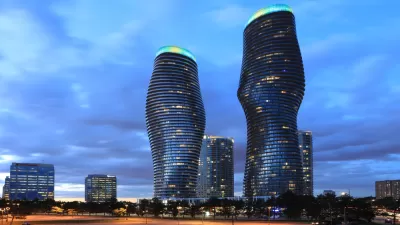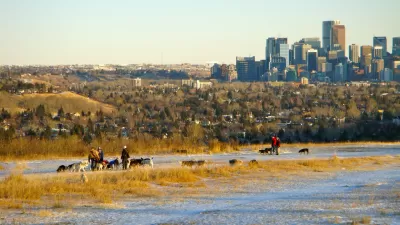As one of North America's largest suburbs, Mississauga is joining some of its neighbors in the Greater Toronto Area in planning an unprecedented effort to replace its suburban roots with something more urban.
Like much of North America, Canada's suburbs have long sprawled in the form of residential subdivisions and automobile-friendly commercial strip development. Now, several suburbs outside of Toronto, including Vaughan, Markham, and Mississauga, are looking to transform their centers into distinctive, walkable, mixed-use neighborhoods.
"What these municipalities are trying to do is unprecedented on this scale in North America. The idea – placing mini-downtowns in far-flung locations, separated from inner-city Toronto by vast stretches of tract housing – runs counter to the traditional model of urban growth," says Adrian Morrow, of The Globe and Mail. "Not everyone is convinced it will work."
Some think bringing downtown-like development to the suburbs is the wrong model. "'To me, it's mildly insane – it's like building more subdivisions,' says Robert MacDermid, an expert in municipal politics at York University. 'Instead, you should be intensifying from the core [of Toronto] outward.'"
Still, many see densification as a necessity. As Morrow notes, "simply sitting back and allowing development to happen where it will – the post-war paradigm in this country – is not an option for those who want to build better cities."
"'We're directing growth where it needs to happen -- not just where the market takes it. That's how you get quality development at the end of the day. We want to take the time to get it right,' says Marilyn Ball, Mississauga's director of development and design. 'We are writing the book on a suburban municipality's shift to a vibrant city.'"
FULL STORY: How Toronto’s suburbs are trying to switch from subdivisions to density

Americans May Be Stuck — But Why?
Americans are moving a lot less than they once did, and that is a problem. While Yoni Applebaum, in his highly-publicized article Stuck, gets the reasons badly wrong, it's still important to ask: why are we moving so much less than before?

Using Old Oil and Gas Wells for Green Energy Storage
Penn State researchers have found that repurposing abandoned oil and gas wells for geothermal-assisted compressed-air energy storage can boost efficiency, reduce environmental risks, and support clean energy and job transitions.

Placekeeping: Setting a New Precedent for City Planners
How a preservation-based approach to redevelopment and urban design can prevent displacement and honor legacy communities.

San Francisco’s Muni Ridership Grew in 2024
The system saw its highest ridership since before the Covid-19 pandemic, but faces a severe budget shortage in the coming year.

Colorado Lawmakers Move to Protect BRT Funding
In the face of potential federal funding cuts, CDOT leaders reasserted their commitment to planned bus rapid transit projects.

Safe Streets Funding in Jeopardy
The Trump administration is specifically targeting bike infrastructure and other road safety projects in its funding cuts.
Urban Design for Planners 1: Software Tools
This six-course series explores essential urban design concepts using open source software and equips planners with the tools they need to participate fully in the urban design process.
Planning for Universal Design
Learn the tools for implementing Universal Design in planning regulations.
Heyer Gruel & Associates PA
City of Moreno Valley
Institute for Housing and Urban Development Studies (IHS)
City of Grandview
Harvard GSD Executive Education
Salt Lake City
NYU Wagner Graduate School of Public Service
City of Cambridge, Maryland





























